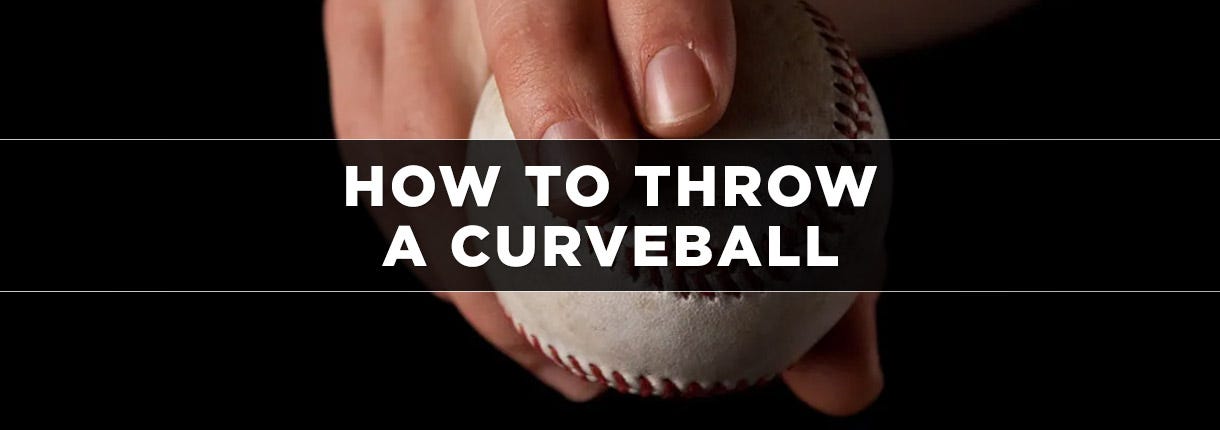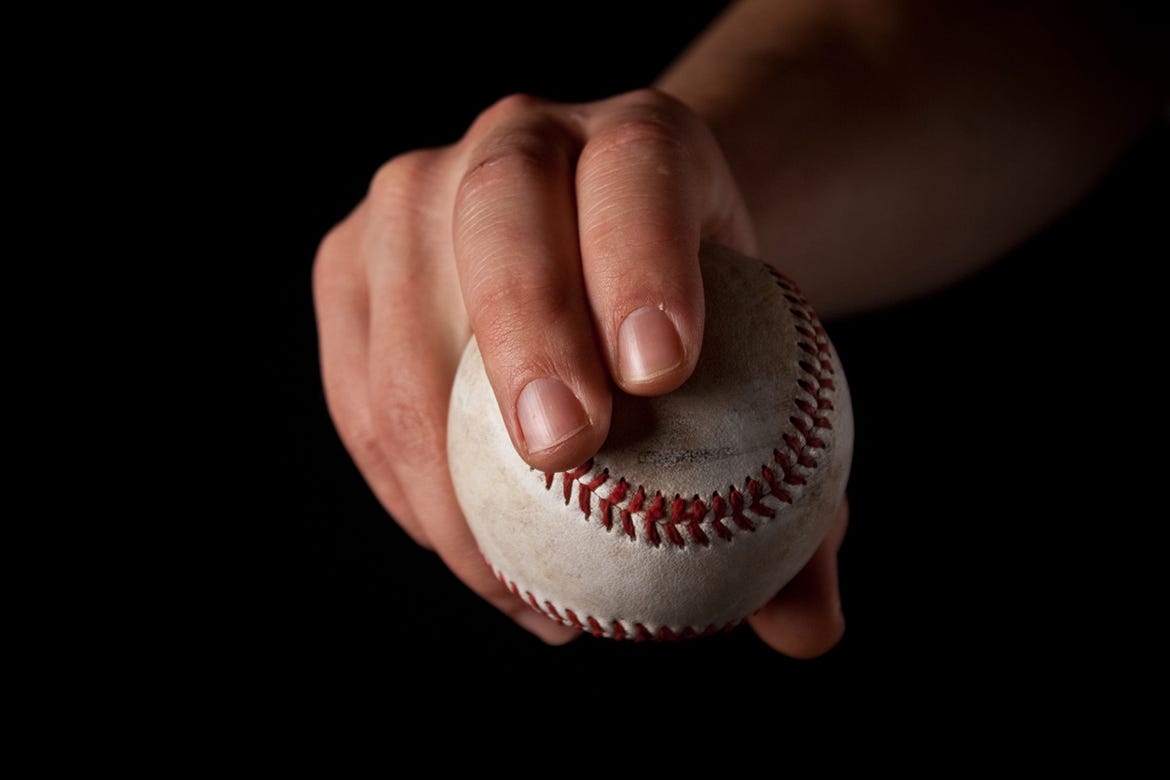How to Throw a Curveball: Proper Grip, Form and Release for Curveballs


The curveball has gone by many names over the years: “the hammer,” “the deuce,” “Uncle Charlie,” just to name a few. Perhaps the reason for this is because the curveball is an important pitch for all pitchers to master, though it can be tricky. If you throw a good one, the hitter stands little chance of hitting it. If you miss the mark, though, you may just end up seeing the hitter’s home run trot.
Before we get into learning how to throw a good curveball, it’s important to note that young pitchers shouldn’t attempt this pitch unless under the proper supervision. A hard limit should be put on the amount of curveballs youth pitchers throw in any given session. Throwing a curveball involves twisting the wrist at the release point, which puts additional stress on the tendons in the elbow and shoulder.
Here we’ll discuss the following essential questions about the curveball:
- What is a Curveball?
- Types of Curveballs
- Steps to Throwing a Curveball (12-6)
- Curveball Nicknames
- Common Questions About Curveballs
What is a Curveball?
A curveball is a type of pitch that’s harder for most batters to hit. Velocity, movement and command are the three components of any pitch. A curveball is different from other pitches for a few reasons. It’s typically 10 mph + slower than a fastball, has dramatic downward movement and should be thrown low in the strike zone.
The point of the curveball is to create topspin, which gives the pitch its late diving action. A fastball or changeup has backspin and stays straight.There’s an element of deception that good pitchers develop, and the curveball pitch is among the most deceptive in any pitcher’s arsenal.
Types of Curveballs
There are three primary types of curveballs: the 12-6 curveball, knuckle curve and slurve, or sweeping curve. Which type of curveball you throw depends mostly on your arm angle, but there’s also different ways to grip the ball. If your release point is directly above your shoulder, you’ll get a curveball that breaks straight downward, and if you release the ball farther away from your body, the curveball will have sideways movement as it dives.
- 12-6 Curveball. The 12-6 curveball gets its name by imagining the way it breaks like the hour markers on a clock. The break will be in a downward motion that’s in a straight line. When the pitcher releases the ball directly above the shoulder, the ball is spinning on an axis parallel to the ground, creating the slow, tumbling effect of the 12-6 curveball.
- Knuckle Curve. The knuckle curveball gets its name from the way it’s gripped, with your knuckle pressed against the baseball. The idea of the knuckle curveball is to get a tighter, faster break with a slight sideways cut as the ball drops.
- Slurve. The slurve curveball is sometimes referred to as the sweeping curveball, because it breaks from one side of the plate to the other. The slurve gets its name from combining “slider” and “curve.” Like the name, the slurve is a combination pitch, taking the topspin of a curve and releasing the pitch with a three-quarters arm angle, creating a tilted axis, so it slides across the strike zone.
Steps to Throwing a Curveball (12-6)
The first step to throwing a curveball is to release the ball at the same point and arm angle as you would a fastball. Since most pitchers release the ball above the head, the 12-6 curveball is the most commonly thrown curveball. Remember, deception is key, so it’s important to not tip the hitter off to what you’re throwing.
Curveball Grip
First you need to grip the ball properly. When gripping a curveball, start by positioning the baseball in your hand so the two seams are parallel with your fingers. Place your middle finger slightly to the inside of the right seam, with your index finger resting right next to it. Your thumb should grip the seam directly below your index finger, so your hand creates a backward C. As previously mentioned, the knuckle curve is thrown with the same grip, only your index finger is curled and pressed against the baseball, creating a tighter break.
Curveball Pitching Motion
The next thing to focus on is your throwing motion. When you’re going through your pitching motion, your elbow should create a 90-degree angle when your hand reaches its release point. Your elbow should be raised higher than your shoulder. If your elbow is at an angle greater than 90-degrees lower than your shoulder, you will put undue stress on it which can cause injury. Everything from the windup to the follow through should be the same as your fastball, except for the release point.
Curveball Release
Finally, you’ll release the ball at the perfect moment. At the moment of releasing your curveball, rotate your wrist so your index and middle fingers are pointing toward your head. Your middle finger should be driving the seam it’s pressed up against downward so your thumb rotates upward. It’s important to release the ball with the same arm speed as you would for your fastball so the hitter isn’t tipped off and so you can get the ball to spin as fast as possible.
Curveball Nicknames
The curveball has been given several nicknames over the years. Here are some of the most popular ones you might hear today:
- Deuce. The curveball is usually a pitcher’s second pitch, after the fastball, so the catcher’s signal for the curveball is usually two fingers, hence the “deuce.”
- Yellow Hammer. This nickname comes from the yellowhammer bird, which catches its prey by diving suddenly and quickly.
- Yakker. The term “yakker” typically refers to a curveball with a big break, but the name came about as shorthand for the yellowhammer bird.
- Uncle Charlie. The origin of this nickname is unclear -- some believe it dates back to the 1920s and references a minor league team owner who was commonly known as “Uncle Charlie.”
- Lord Charles. Though the “Uncle Charlie” nickname isn’t totally clear, “Lord Charles” is. It was coined in the 1980s because Dwight Gooden’s curveball was so good, calling it an “Uncle Charlie” wasn’t enough -- the “uncle” became a “lord.”
- Bender. The “bender” nickname is pretty straightforward -- the path of the curveball bends in mid air.
- Hook. Like the “bender” nickname, “hook” also describes the curveball’s trajectory, but it could also refer to the shape the hand makes when gripping it.
Common Questions About Curveballs
Should kids throw curveballs?
Kids should not throw curveballs until they are well into their teenage years. When throwing curveballs, the snapping motion you make with your wrist puts stress on the tendons in your elbow and shoulder. If your hand isn’t large enough to properly grip the ball, that stress is drastically exaggerated.
Can throwing curveballs hurt your arm?
Throwing curveballs can hurt your arm for several reasons. In addition to those just listed above, if you don’t throw it properly you could also end up injured. Remember to keep your elbow at an angle no greater than 90 degrees, and it needs to be raised above your shoulder.
Why does a curveball break?
A curveball breaks downward because it’s thrown with topspin, whereas a fastball is thrown with backspin. Imagine putting the baseball on the ground and rolling it forward and you can visualize what topspin looks like.
Why is my curveball not breaking?
A common issue for many pitchers, even professionals, is having a hard time getting “on top” of their curveball. You should be releasing your curveball close to your body in order to maximize the tension between your middle finger and the seam, which increases the spin rate and, thus, the curveball’s break.
What is a hanging curveball?
A hanging curveball is a curveball that doesn’t break or isn’t thrown low enough in the zone. Because it’s thrown at a slower velocity than a fastball, a hitter has a few more precious moments to react to it. If the ball doesn’t break or doesn’t break enough, it’s much easier for a hitter to make solid contact.






Login and Registration Form
or
Create an account